Headlines and events archive
Displaying 401 - 450 of 1543
You may also find an archive of news published in the media which are related with the Instituto de Astrofísica de Andalucía - CSIC.
Pages
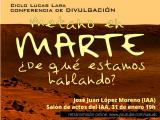
|
31/01/2019 - 19:00
Methane in Mars: what are we talking about? We review the evidence of the existence of methane on Mars and its possible implications. José Juan López Moreno |
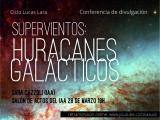
|
28/03/2019 - 19:00
Superwinds: galactic hurricanes Galactic superwinds, common phenomena in galaxies, are capable of releasing an extraordinary amount of energy and transporting material over long distances. Their influence on the host galaxy can be of great importance, to the extent that the formation of these "galactic hurricanes" can even determine the life of galaxies. The study of these phenomena provides us with some keys to solving the enigmas of modern astronomy about the evolution of... Sara Cazzoli |

|
25/04/2019 - 19:00
The first image of a black hole The Horizon Event Telescope (EHT), a planetary-scale telescope made up of eight radio telescopes and forged through international collaboration, was designed to capture the first image of a black hole. In a series of simultaneous international press conferences on April 10, EHT researchers revealed that they had succeeded and showed the first direct visual evidence of a super-massive black hole and its shadow. José Luis Gómez |
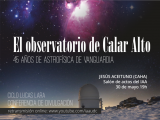
|
30/05/2019 - 19:00
The Calar Alto Astronomical Observatory: 45 years of cutting-edge astronomy It has been 45 years since Calar Alto Observatory was founded. An observatory that, among its merits, has been one of the main engines of the development of astronomy in Spain and, of course, one of the foundations of the creation of the Instituto de Astrofísica de Andalucía (Andalusian Astrophysics Institute). This year the observatory goes from being Hispano-German to being totally Hispanic, with the incorporation of the Junta de Andalucía... Jesús Aceituno |

|
27/06/2019 - 19:00
Climate change in Mars Outreach conference about the atmosphere and climate variability of the red planet Francisco González Galindo |

|
19/11/2019 - 12:30
METIS instrument: the IMAGER and the SCAO METIS is one of the three first instruments for the European Extremely Large Telescope (ELT), Europe’s next-generation ground-based telescope for optical and infrared wavelengths which is currently under construction at the ESO site at Cerro Armazones in Chile. METIS is the Mid-infrared ELT Imager and Spectrograph. This instrument will offer imaging, coronagraphy and medium-resolution spectroscopy over the full wavelength range from 3 to 14... Dr. Concepción Cárdenas |

|
07/10/2019 - 12:30
SO Colloquia: FPGAs in space: current experiences, future challenges and opportunities FPGAs are key components in space equipment due to their versatility and performance to implement digital functions. They are embarked in satellites and used in many applications; such as observing the earth, provide telecommunications and navigation services as well as to contribute to science and explore the wider Universe. The FPGAs face very different conditions in space compared to the terrestrial applications, especially due to the... Merodio Codinachs |

|
25/06/2019 - 12:30
Properties of ionized outflows in MaNGA DR2 galaxies Feedback originated from star formation and AGN activity in galaxies can have a significant impact on their evolution. The action of feedback leads to several processes that might have a significant effect on the surrounding gas, for example by heating the system, halting or enhancing star formation, or enriching the interstellar medium. Constraining the incidence and properties of feedback events such as ionized outflows is therefore crucial to... Bruno Rodríguez Del Pino |

|
04/06/2019 - 12:30
Correlations between the size and the stellar population properties of quiescent galaxies During the last decades, many authors have put large efforts to shed light on the mechanisms responsible of the generalized growth in size of galaxies, as well as to disentangle the main “driver” of their stellar content. In our study, we aim at stating new constraints on the mechanisms that may drive the growth in size of massive galaxies through the study of the stellar population properties of quiescent galaxies within the stellar mass-... Dr. Luis Díaz García. |

|
18/06/2019 - 12:30
Oxygen Line Diagnostics in X-ray spectroscopy Line diagnostics is very important to understand the physics of astronomical sources. Taking advantage of oxygen line diagnostics in X-ray spectroscopy, I will show some of our research for both the moderate-resolution the high-resolution X-ray spectra based on the newly updated atomic database (ATOMDB). I will demonstrate its power for SgrA spectrum, HII regions, and some nearby galaxies. In addition, I will introduce related space mission... Dr. Li Ji |

|
24/05/2019 - 11:30
A prototype SKA Science Regional Centre at the IAA In this seminar we will describe our involvement in the design of the SRCs, how we are preparing for hosting an SRC at the IAA - one of the strategic objectives of the IAA Severo Ochoa programme - as well as potential benefits for the IAA and collaboration opportunities, such as the one already started with the PLATO team. We will conclude by illustrating the challenges associated with following Open Science principles with an example of their... Lourdes Verdes-Montenegro, Susana Sánchez, Michael G. Jones |

|
09/07/2019 - 12:30
The Orientation of the Collimated Outflows of Planetary Nebula: Independence Day The discovery of collimated outflows in planetary nebulae (PNe) has changed the paradigm of PN formation. They actively participate in the nebular shaping immediately before or while fast stellar winds and D-type ionization fronts shock and swept the nebular envelope. The general properties of collimated outflows of PNe cannot be studied because projection effects do not allow us to determine their space velocities and linear sizes. The large... Jackeline Suzett Rechy Garcia & Martin A. Guerrero |

|
17/05/2019 - 12:30
TIDES, PLANETARY WAVES, AND ATMOSPHERIC COUPLING A growing number of studies report linkages between unrelated stratospheric and upper atmospheric phenomena. For example, stratospheric warmings correlate with ionospheric perturbations, and with reductions in polar mesospheric cloud occurrence. Understanding these so-called teleconnections is important for prediction of the near-space environment, and interpreting global change proxies. Tides and planetary waves are important agents for... Dr. Ruth Lieberman |

|
19/06/2019 - 11:00
SO Colloquia: Searching extended line-emission objects in wide-field surveys: The IPHAS experience One of the problems we are facing in the study of evolved low- and intermediate-mass stars such as Planetary Nebulae (PNe) is the lack of completeness. Most known PNe belong to the bright or intermediate part of the luminosity function, leaving out those at the faint end. Any global chemical, kinematical, and physical analysis of the PN population is therefore biased. In 2003 the INT Photometric Halpha Survey started scanning the... Dra. Laurence Sabin |

|
13/06/2019 - 12:30
SO Colloquium: Back to Orion Orion is the massive star formation region closest to the Sun and in consequence it has been studied in detail. I will present three recent results from the IRyA group on this region. The first one is the ultraprecise determination of the distance to Orion using VLBI observations of stars with non-thermal emission. The second result is a study of the kinematics of the stars with either termal or non-thermal emission. Finally, we will focus on... Dr. Luis F. Rodríguez |

|
07/06/2019 - 12:30
The Very Large Array Sky Survey (VLASS) and the next generation Very Large Array (ngVLA) The VLASS is part of a new generation of radio sky surveys. It covers the entire sky above -40 degrees declination. Observations started with the Karl G. Jansky Very Large Array in 2017 and the first epoch covering the entire survey area will be completed by July 2019. This will be followed by two more complete passes with an anticipated completion by 2024. In comparison to previous surveys, the observations are performed at 2-4 GHz and at... Dr. Frank Schinzel |

|
03/05/2019 - 12:30
An ionised bubble before the epoch of re-ionisation In a search for Lyman Alpha sources around two spectroscopically confirmed star forming sources in the Subaru Deep Field, we have found some 45 low luminosity star forming galaxies. We find that these sources form a proto-cluster. Moreover, they reside in an ionised bubble of at least 12000 cMpc^3. Dr. Jose Miguel Rodriguez Espinosa |

|
31/10/2019 - 12:30
SO-IAA Colloquium: Neutral and molecular gas outflows as tracers of the impact of radio jets Our view of the gas and its physical conditions in the central region of AGN has been enriched by the discover of fast and massive outflows of HI and molecular gas. These outflows can be driven by radiation/winds but also by the interaction of the radio plasma with the ISM. Understanding the origin and quantifying their impact requires to trace their location and derive their physical conditions (density of the gas, mass, mass outflow rate and... Dr. Raffaella Morganti |

|
04/04/2019 - 12:30
Is there still hope for discovering new physics in the Euclid era? The new generation of cosmological surveys like DESI, J-PAS and Euclid will measure the effect of dark energy on the expansion history of the universe. They will obtain optical and NIR spectra for tens of millions of galaxies and quasars, constructing a 3-D map spanning the nearby universe to 10 billion light-years, and will provide an accurate determination of the distance-redshift relation. I will review the latest distance scale measurements... Dr. Francisco Prada |

|
27/06/2019 - 12:30
Stellar Tidal Streams in Nearby Galaxies as Dark Matter Probes Mergers and tidal interactions between massive galaxies and their dwarf satellites are a fundamental prediction of the Lambda-Cold Dark Matter cosmology. These events are thought to influence galaxy evolution throughout cosmic history and to provide important observational diagnostics of nonlinear structure formation. Thin stellar streams in the Milky Way and Andromeda galaxies are spectacular evidence for satellite disruption at the... Dr. David Martinez-Delgado |

|
21/03/2019 - 12:30
Primer Plan de igualdad del IAA El objetivo de esta charla es presentar a todo el Instituto el I Plan de Igualdad de género. Plantearé las motivaciones y necesidades de contar con un plan de igualdad en un instituto de investigación, cuando ya el CSIC está preparando su III Plan de Igualdad. Revisaré los objetivos y marco de actuación de los planes del CSIC y mi visión de cómo el nuestro se hace para complementar algunas acciones no contempladas dentro de esa estructura... Dra. Josefa Masegosa |

|
18/06/2018 - 12:30
Large-IFS for CAHA & LUCA: Local Universe from Calar Alto LoI for new instruments for 3.5m Telescope F. Prada, E. Perez-Jimenez, R. Gonzalez Delgado, R. Garcia Benito |
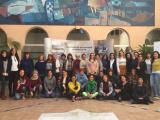
|
07/02/2019
International Day of Women and Girls in Science The Institute of Astrophysics of Andalusia joins the celebration of the International Day of Women and Girls in Science, which seeks to make visible the scientific work of women and promote vocations in girls |

|
19/02/2019 - 12:00
Instrument development at the AAO The AAO is a consortium of three Australian instrumentation groups, based at Macquarie University, University of Sydney, and the Australian National University. Collectively, the consortium has delivered hundreds of instrument projects for astronomy, for our own telescopes and internationally. We have particular expertise in fibre positioners and fibre systems, spectrographs, astro-photonics, and adaptive optics. I will give an... Jon Lawrence |

|
09/05/2019 - 12:30
Nonlinear dynamics of space and astrophysical plasmas Solar atmosphere and solar wind provide a unique laboratory for understanding the nonlinear dynamics of space and astrophysical plasmas. A quantitative analysis of the reconnection condition and the degree of intermittency reveals that rope–rope magnetic reconnection is the most likely site for genesis of interplanetary intermittency turbulence in this event. The dynamic pressure pulse resulting from this reconnection triggers the onset of a... Prof. Abraham Chian |

|
28/03/2019 - 12:30
CTA: the Cherenkov Telescope Observatory for VHE Gamma Ray astronomy The Cherenkov Telescope Array (CTA), currently in construction, shall be the Cherenkov Telescope Observatory for VHE Gamma Ray Astronomy, and shall provide crucial data for the understanding of the extreme universe in the recently open multimessenger era. The goals and characteristics of the project will be reviewed, and the current status and plans presented. In addition, the crucial role of the Spanish community in this project will be... Manel Martinez |

|
16/05/2019 - 12:30
Active Galactic Nuclei and their large-scale structure: an eROSITA mock catalogue I will present in this talk a methodology to construct mock catalogs for X-ray selected AGN samples based on dark matter only N-body simulations. With this method, we predict observed AGN magnitudes in the UV, optical and NIR bands, by adopting a set of empirical spectral energy distributions. Dr. Johan Comparat |

|
25/04/2019 - 12:30
Cosmic Dust in Planetary Atmospheres In this seminar I will describe the results of a large study designed to determine the input rate of cosmic dust to the terrestrial atmosphere, using a self-consistent treatment of cosmic dust from the outer solar system to the Earth’s surface. John Plane |
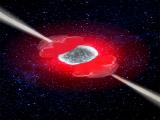
|
13/03/2019 - 12:30
Signatures of a jet cocoon in early spectra of a supernova associated with a gamma-ray burst Thanks to a detailed observational monitoring and an accurate spectral synthesis analysis of the early phases of SN 2017iuk, we conclude that these features originate from the mildly relativistic hot cocoon that is generated by the GRB ultra-relativistic jet, while it is expanding and decelerating into the medium surrounding the progenitor star. Dr. Luca Izzo |

|
10/01/2019 - 12:30
The road to the Square Kilometre Array New and existing facilities operating at submm-to-m wavelengths are shedding new light on the formation of planets, black holes, and even the first galaxies. These telescopes provide the test bed for the technological advancements required to build the next generation of large radio telescopes, like the Square Kilometre Array (SKA). Dr. Jeff Wagg |

|
07/03/2019 - 12:30
High-velocity Molecular Clouds near the Galactic Center The central region of our Galaxy contains a huge amount of molecular gas. This region is often referred to as the "central molecular zone (CMZ)". The recent ALMA observations toward this HVCC revealed orbital motions around an invisible massive object, which is probably an intermediate-mass black hole. Yuhei Iwata |

|
13/02/2019 - 12:30
THOT: Dating stars Life, planets, exoplanetary systems, stars, and our galaxy evolve with time, and the best and sometimes only way for understanding this evolution is dating stars. THOT is a Marie Curie Project devoted to gathering and updating all the stellar dating techniques into a single computational tool. In this presentation, I will present some of the most promising techniques for stellar dating, and show the current main contributions of this project (... Dr. Andres Moya |

|
15/11/2018 - 12:30
The habitability of stagnant-lid Earths around dwarf stars We show that Earth-like stagnant-lid planets allow for habitable surface conditions within a continuous habitable zone that is dependent on interior composition. Dra. Mareike Godolt |

|
08/11/2018 - 12:30
What we (don't) know about the trans-Neptunian objects The first trans-Neptunian object was discovered in 1930 and we waited over 60 years to discover the second one. The discovery of Albion (a.k.a. 1992QB1) enticed the minor bodies community to characterize the new population, called collectively as trans-Neptunian objects (TNOs). Today we know the existence of over 2,000 objects and counting. Nevertheless, it seems that we have reached our technological limitation in terms of observational studies... Dr. Alvaro Alvarez-Candal |
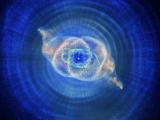
|
29/11/2018 - 12:30
Spirals, rings and arcs around evolved stars We searched the complete archive of the HST and Spitzer to characterise rings and arcs around evolved low-mass stars (AGB stars, proto-PNe and PNe), study their physical properties and address their formation mechanisms. In this talk, we present the observational results of our survey, the predictions of simple radiation-hydrodynamic simulations as well as the future of the project. Dr. Jesús Toala |

|
22/11/2018 - 12:30
Time variable processes of Sagittarius A*, the massive black hole at the centre of the Milky Way Date: 22/11/2018 . 12:30 hrs Speaker: Dr. Gunther Witzel Affiliation: Max-Planck-Institute for Radioastronomy, Bonn, Germany. Dr. Gunther Witzel |

|
07/02/2019 - 12:30
Mars UV atmospheric emissions In this talk we will summarize our recent analysis of observations performed by the instrument SPICAM on the Mars Express mission on the dayside of the planet, and by the instrument IUVS on board MAVEN on the nightside of the planet. Dr. Francisco González Galindo |

|
13/12/2018 - 12:30
RESULTS FROM THE RADIOASTRON AGN POLARIZATION KSP: A LIMB-BRIGHTENED JET IN 3C273 The RadioAstron active galactic nuclei (AGN) polarization Key Science Project (KSP) aims at exploiting the unprecedented angular resolution provided by RadioAstron to study jet launching/collimation and magnetic-field configuration in AGN jets. The targets of our KSP are some of the most powerful blazars in the sky. I will present observations at 1.4 GHz and 22 GHz of 3C273, performed in 2014, designed to reach a maximum baseline of... Gabriele Bruni |

|
12/04/2019 - 12:30
Imaging a black hole with the Event Horizon Telescope We have imaged the shadow of the central black hole in the radiogalaxy M87. This required assembling the Event Horizon Telescope, a global VLBI array observing at a wavelength of 1.3 mm capable of achieving an angular resolution of 20 microarcsecond (uas). We have resolved the central region of M87 into an asymmetric bright emission ring with a diameter of 42+-3 uas, which is circular and encompass a central depression in brightness with a flux... Dr. Jose Luis Gómez |
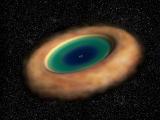
|
17/01/2019 - 12:30
AGN TORUS DETECTABILITY AT SUB-MILLIMETER WAVELENGTHS: WHAT TO EXPECT FROM ALMA CONTINUUM DATA In this talk I will show you a study on the detectability of the emission associated with the AGN dusty structure at sub-mm wavelengths using ALMA, in a theoretical and observational way. Dr. Alice Pasetto |
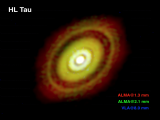
|
24/01/2019 - 12:30
Observing Planet Formation with the VLA in the era of ALMA In only four years, ALMA has radically changed the field of planet formation. We are currently obtaining very detailed images of the dust emission in protoplanetary disks with an unprecedent sensitivity and high angular resolution. Dr. Carlos Carrasco |

|
21/02/2019 - 12:30
Planck Cosmological Legacy: the next CMB polarization experiments The results and products derived from the third and final release of data from the Planck mission will be reviewed with emphasis on the implications for cosmology. Prof. Enrique Martinez |

|
27/09/2018 - 12:30
ASKAP and HI in Galaxies I will divide my talk into three parts, starting with an overview of CSIRO’s Australia Telescope National Facility (ATNF), especially our telescopes (ASKAP... Baerbel Koribalski |
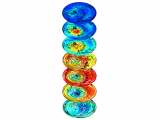
|
18/10/2018 - 12:30
An unusual autumn Elevated Stratopause Event (ESE) IAA Seminar Date: 18/10/2018 . 12:30 hrs Speaker: Dr. Maya Garcia Comas Dr. Maya García Comás |

|
11/10/2018 - 12:30
The planetary nebula HuBi 1, a rebel with a cause Planetary nebulae, the descendants of low- and intermediate-mass stars, have characteristic onion-like ionization structure, with the highest ionization species closer to the central star. This is true for all planetary nebulae, but HuBi 1, which shows an inverted ionization inner shell. There is a reason for this oddity, a peculiar stellar evolution of its central star, which makes HuBi 1 the missing link of the population of cool C-rich... Dr. Martin Guerrero |

|
06/09/2018 - 12:30
Optical spectroscopy of local type-1 AGN LINERs The Balmer emission originated in the broad line region (BLR) of active galactic nuclei (AGNs) could be either weak and difficult to detect, or even absent, for low luminosity AGNs, as low ionization nuclear emission-line regions (LINERs). This makes LINERs challenging to fit in the AGN unification scheme. Moreover, a long debate can be found in the literature proposing different ionization sources at the origin of optical emission lines and no... Dr. Sara Cazzoli |
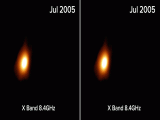
|
25/10/2018 - 12:30
The Arp299B-AT1 puzzle: First resolved imaging of a tidal disruption event Date: 25/10/2018 . 12:30 hrs Speaker: Dr. Miguel Angel Pérez-Torres Affiliation: IAA-CSIC, Spain Dr. Miguel Angel Pérez-Torres |

|
28/06/2018 - 12:30
Extreme quasars at high redshift The study of the AGN accreting close to the Eddington limit (L/LEdd~1) has taken an important role, due to their potential use as standard candles for cosmological applications. With the purpose to understand the physics of extreme quasar, we perform a spectroscopic analysis of a sample of highly accreting quasars at high redshift (z~2–3). Our sample were observed with the OSIRIS spectrograph on the GTC 10.4 m telescope located at the... Dr. Maryloli Martinez Aldama |

|
13/09/2018 - 12:30
The peculiar case of the active galactic nuclei in PBC J2333.9-2343 Under unification schemes, active galactic nuclei (AGN) can be explained by orientation effects. However, some sources show properties at different frequencies that led to incongruent classifications and cannot be explained by such unification scheme. This is the case of PBC J2333.9-2343; its optical spectrum is of a type 2 AGN but its X-ray spectrum does not show signs of absorption, and in the radio it has many features typical of a blazar but... Dr. Lorena Hernández-García |

|
20/09/2018 - 12:30
Slender CaiiH fibrils observed by SUNRISE II The special observing conditions of the SUNRISE observatory allow obtaining observations in the UV with unprecedented temporal stability and spatial resolution. On its second scientific flight, the Sunrise Filter Imager (SUFI) was used to record a time series of narrow-band intensity images in the CaiiH line for approximately one hour at a cadence of 7 seconds. This unique dataset enabled us to characterize the morphological properties of 598... Dr. Ricardo Gafeira |